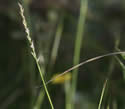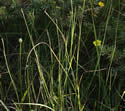Muhlenbergia richardsonis (Mat Muhly)
| Also known as: | |
|---|---|
| Genus: | Muhlenbergia |
| Family: | Poaceae (Grass) |
| Life cycle: | perennial |
| Origin: | native |
| Habitat: | sun; moist to wet; calcareous fens, bogs, sedge meadows, wet prairies |
| Fruiting season: | August - October |
| Plant height: | 4 to 12 inches |
| Wetland Indicator Status: | GP: FAC MW: FAC NCNE: FACW |
| MN county distribution (click map to enlarge): |  |
| National distribution (click map to enlarge): |  |
Pick an image for a larger view. See the glossary for icon descriptions.
Detailed Information
Flower: 


![[photo of panicle]](/udata/r9ndp23q/pd3/muhlenbergia-richardsonis-080416-30-t.jpg) Erect, very slender, branching cluster 1 to 5 inches long at the top of the stem. Panicle branches are appressed with a few to several short-stalked spikelets (flower clusters) per branch. Spikelets are lance-elliptic in outline, 1.5 to 3 mm (to 1/8 inch) long, overlapping along a branch but not tightly crowded, and usually have a single floret, occasionally 2.
Erect, very slender, branching cluster 1 to 5 inches long at the top of the stem. Panicle branches are appressed with a few to several short-stalked spikelets (flower clusters) per branch. Spikelets are lance-elliptic in outline, 1.5 to 3 mm (to 1/8 inch) long, overlapping along a branch but not tightly crowded, and usually have a single floret, occasionally 2.
![[close-up of branch]](/udata/r9ndp23q/pd3/muhlenbergia-richardsonis-070316-s2-t.jpg) At the base of a spikelet is a pair of bracts (glumes), both thin, green to straw-colored, 1-veined, hairless, lance to egg-shaped with a rounded to pointed tip, sometimes with an awn-like extension up to .2 mm long at the tip, the lower glume .5 to 2 mm long, the upper glume slightly longer than the lower glume and 1/3 to half as long as the spikelet. Florets are surrounded by a pair of bracts (lemma and palea), both similar in size and shape, mottled dark green to blackish, hairless, 1.5 to 3 mm long, pointed at the tip, the lemma 3-veined often with an awn-like extension up to .5 mm long at the tip, and the palea 2-veined.
At the base of a spikelet is a pair of bracts (glumes), both thin, green to straw-colored, 1-veined, hairless, lance to egg-shaped with a rounded to pointed tip, sometimes with an awn-like extension up to .2 mm long at the tip, the lower glume .5 to 2 mm long, the upper glume slightly longer than the lower glume and 1/3 to half as long as the spikelet. Florets are surrounded by a pair of bracts (lemma and palea), both similar in size and shape, mottled dark green to blackish, hairless, 1.5 to 3 mm long, pointed at the tip, the lemma 3-veined often with an awn-like extension up to .5 mm long at the tip, and the palea 2-veined.
Leaves and stems: 

![[photo of leaves]](/udata/r9ndp23q/pd3/muhlenbergia-richardsonis-080416-5-t.jpg) Leaves are alternate, up to 2 inches long, 1 to 2 mm wide, flat or more often rolled in along the edges (involute), smooth to slightly rough-textured on the lower surface, minutely hairy on the upper surface.
Leaves are alternate, up to 2 inches long, 1 to 2 mm wide, flat or more often rolled in along the edges (involute), smooth to slightly rough-textured on the lower surface, minutely hairy on the upper surface.
![[photo of sheath]](/udata/r9ndp23q/pd3/muhlenbergia-richardsonis-080416-32-t.jpg) Sheaths are hairless. The ligule (membrane where the leaf joins the sheath) is 1 to 3 mm long and lacks a fringe of hairs. Nodes are smooth to rough-textured. Stems are slender, usually branched, hairless except minutely hairy below the nodes, and may be erect but more often prostrate from the base and arising at a lower node (geniculate), and forming mats of mixed flowering and vegetative shoots from scaly rhizomes.
Sheaths are hairless. The ligule (membrane where the leaf joins the sheath) is 1 to 3 mm long and lacks a fringe of hairs. Nodes are smooth to rough-textured. Stems are slender, usually branched, hairless except minutely hairy below the nodes, and may be erect but more often prostrate from the base and arising at a lower node (geniculate), and forming mats of mixed flowering and vegetative shoots from scaly rhizomes.
Fruit: 
![[photo of mature spikelets]](/udata/r9ndp23q/pd3/muhlenbergia-richardsonis-s2-t.jpg) Mature florets drop off individually leaving the glumes behind on the stalk. Grains (seeds) are 1 to 1.5 mm long, light brown.
Mature florets drop off individually leaving the glumes behind on the stalk. Grains (seeds) are 1 to 1.5 mm long, light brown.
Notes:
Muhlenbergia is a rather variable genus: clusters spike-like or an open panicle; glumes or lemmas awned, or neither; the callus (base of the floret) covered in long hairs or not; some with hairy stems or sheaths, others hairless; some branched, some not; clump forming or not; annual or perennial. What they have in common are spikelets usually single-flowered (occasionally with 2 or 3 florets), membranous ligules (occasionally also fringed with hairs), narrow leaves, glumes usually 1-veined, lemmas usually 3-veined, paleas 2-veined, and mature florets usually dropping off above the glumes (occasionally at the spikelet branch). There are about 70 species native to North America and more than 150 species worldwide.
Mat Muhly is mostly found in counties west of the Mississippi River in the moist to wet soils of prairies, sedge meadows, bogs and fens that are often calcareous, saline or marly. Of the 10 Muhlenbergia species known to be in Minnesota, it is one of two with very slender spike-like panicles and awnless spikelets. It is distingushed by the mat-forming habit, very narrow leaves often rolled in on the edges and rarely longer than 2 inches, glumes usually half or less as long as the spikelet, hairless lemmas, ligules 1 to 3 mm long, and stems minutely hairy around the nodes. It commonly becomes infected with a smut fungus that forms yellowish, teardrop-shaped, gall-like structures on the florets.
Most similar is Plains Muhly (Muhlenbergia cuspidata), which is also known to become infected with smut but is densely clump-forming, has a thickened/bulbous stem base, ligules less than 1 mm long, glumes more than half as long as the spikelet, lemmas with sparse appressed hairs, and is found in dry habitats. Nimblewill (Muhlenbergia schreberi) is also mat-forming, but has awned lemmas, a hairy callus, the lower glume is absent altogether and the upper is less than .5 mm long. The spike-like panicle also resembles some Sporobolus species, which typically have some or all the panicle branches hidden inside the sheaths.
Native Plant Nurseries, Restoration and Landscaping Services ↓
More photos
Photos by Peter M. Dziuk taken in Mahnomen County.
Comments
Have you seen this plant in Minnesota, or have any other comments about it?







 Mat Muhly plant
Mat Muhly plant Mat Muhly plant
Mat Muhly plant maturing panicle
maturing panicle florets infected with a smut fungus
florets infected with a smut fungus